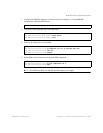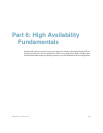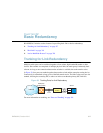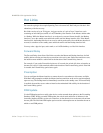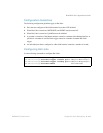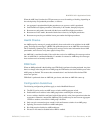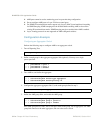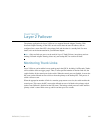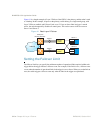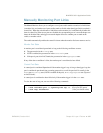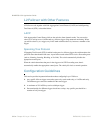BLADEOS 6.5.2 Application Guide
BMD00220, October 2010 Chapter 22: Basic Redundancy 321
When the AMP loop is broken, the STP port states are set to forwarding or blocking, depending on
the switch priority and port/trunk precedence, as follows:
An aggregator's port/trunk has higher precedence over an access switch's port/trunk.
Static trunks have highest precedence, followed by LACP trunks, then physical ports.
Between two static trunks, the trunk with the lower trunk ID has higher precedence.
Between two LACP trunks, the trunk with the lower admin key has higher precedence.
Between two ports, the port with the lowest port number has higher precedence.
Health Checks
An AMP keep-alive message is passed periodically from each switch to its neighbors in the AMP
group. The keep-alive message is a BPDU-like packet that passes on an AMP link even when the
link is blocked by Spanning Tree. The keep-alive message carries status information about AMP
ports/trunks, and is used to verify that a physical loop exists.
An AMP link is considered healthy if the switch has received an AMP keep-alive message on that
link. An AMP link is considered unhealthy if a number of consecutive AMP keep-alive messages
have not been received recently on that link.
FDB Flush
When an AMP port/trunk is the blocking state, FDB flush is performed on that port/trunk. Any time
there is a change in the data path for an AMP group, the FDB entries associated with the ports in the
AMP group are flushed. This ensures that communication is not blocked while obsolete FDB
entries are aged out.
FDB flush is performed when an AMP link goes down, and when an AMP link comes up.
Configuration Guidelines
The following configuration guidelines apply to Active MultiPath Protocol:
The G8124 can be used as an AMP access switch or AMP aggregator switch.
Enable AMP on all switches in the AMP group before connecting the switch ports.
Access switches should be configured with a higher priority value (lower precedence) than the
aggregators. Otherwise, unexpected AMP keep-alive packets may be sent from one aggregator
switches to another, even when its AMP group is disabled.
Only one active connection (port or trunk) is allowed between switches in an AMP group.
Spanning Tree must be disabled on AMP trunks/ports.
Hot Links must be disabled on AMP trunk/ports.
Private VLANs must be disabled before AMP is enabled.



